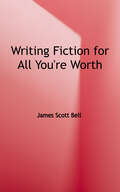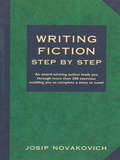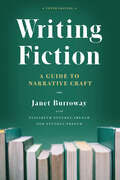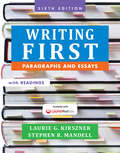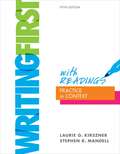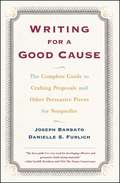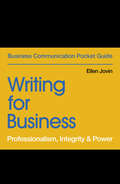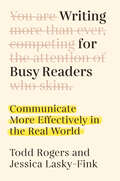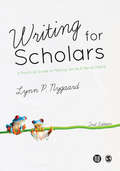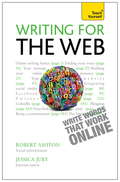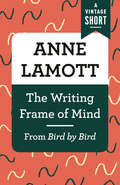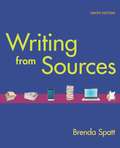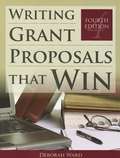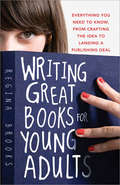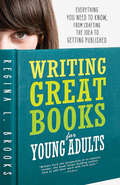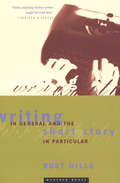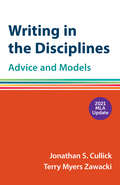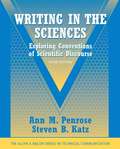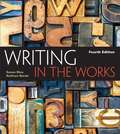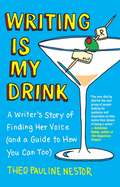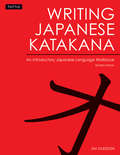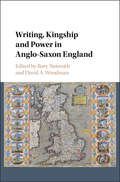- Table View
- List View
Writing Fiction for All You're Worth
by James Scott BellTake your fiction to that next level, where agents and editors sit up and take notice - and where readers keep coming back for more! This book contains the best of James Scott Bell's articles and blog posts on writing, easily searchable under these headings: The Writing World, The Writing Life, and The Writing Craft. And you'll get never before published material, including a first-ever look into Jim's secret writing notebook, the manual he put together over the years for his own use in writing numerous bestsellers. For the first time he's sharing a glimpse into the notes he compiled on his way to publishing success. Plus, a special module on getting into e-publishing, which is a must read if you want to have a career selling e-books successfully.
Writing Fiction Step by Step: An Award-Winning Author Leads You Through More than 200 Exercises Enabling You to Complete a Story or Novel
by Josip NovakovichWriting Fiction Step by Step gives you more than 200 exercises that will sharpen your writing skills while helping you develop complete short stories, even novels. In this sequel to his very popular Fiction Writer's Workshop, Whiting Award-winning author Josip Novakovich shows you that writing fiction is about making connections–between character and plot, setting and conflict, memory and imagination. You'll make these connections by linking the exercises. A character invented in chapter two can appear in a scene outlined in chapter eight and can speak in a voice developed in chapter ten. Embark on a unique writing journey and learn step by step how to craft fiction that captivates readers.
Writing Fiction, Tenth Edition: A Guide to Narrative Craft (Chicago Guides to Writing, Editing, and Publishing)
by Janet Burroway Elizabeth Stuckey-French Ned Stuckey-FrenchMore than 250,000 copies sold! A creative writer’s shelf should hold at least three essential books: a dictionary, a style guide, and Writing Fiction. Janet Burroway’s best-selling classic is the most widely used creative writing text in America, and for more than three decades it has helped hundreds of thousands of students learn the craft. Now in its tenth edition, Writing Fiction is more accessible than ever for writers of all levels—inside or outside the classroom. This new edition continues to provide advice that is practical, comprehensive, and flexible. Burroway’s tone is personal and nonprescriptive, welcoming learning writers into the community of practiced storytellers. Moving from freewriting to final revision, the book addresses “showing not telling,” characterization, dialogue, atmosphere, plot, imagery, and point of view. It includes new topics and writing prompts, and each chapter now ends with a list of recommended readings that exemplify the craft elements discussed, allowing for further study. And the examples and quotations throughout the book feature a wide and diverse range of today’s best and best-known creators of both novels and short stories. This book is a master class in creative writing that also calls on us to renew our love of storytelling and celebrate the skill of writing well. There is a very good chance that one of your favorite authors learned the craft with Writing Fiction. And who knows what future favorite will get her start reading this edition?
Writing First with Readings
by Laurie G. Kirszner Stephen R. MandellBest-selling authors and veteran college writing instructors Laurie Kirszner and Stephen Mandell believe that students learn to write best when they use their own writing as a starting point. In Writing First with Readings: Paragraphs and Essays, the authors take a simple yet effective approach to helping students improve their writing skills: visual writing prompts open every chapter and get students writing immediately. Then, throughout the chapter, students move between their own writing, writing models and instruction, and workbook-style mastery exercises so that they continually revise, rewrite, and improve their own writing. It is this formula that makes writing instruction meaningful and accessible for students. Thoughtful chapters on academic writing and success, research, and critical reading, along with high-interest essays, round out this new edition, making it the perfect introduction to college writing.
Writing First With Readings: Practice In Context
by Laurie G. Kirszner Stephen R. MandellBest-selling authors and veteran college writing instructors Laurie Kirszner and Stephen Mandell believe that students learn to write best when they use their own writing as a starting point. In Writing First with Readings: Practice in Context, designed for the paragraph to essay course, Kirszner and Mandell take seriously the ideas and expressive abilities of developmental students, as well as their need to learn the rules of writing and grammar. Visual writing prompts that open every chapter get students writing immediately. By moving frequently between their own writing, writing models and instruction, and workbook-style mastery exercises, students get constant reinforcement of the skills they are learning. Thoughtful chapters on college success, research, and critical reading, along with high-interest essays, round out the text, making it the perfect introduction to college writing.
Writing For a Good Cause
by Joseph Barbato Danielle FurlichFilled with tips and survival skills from writers and fund-raising officers at nonprofits of all sizes, Writing for a Good Cause is the first book to explain how to use words well to win your cause the money it needs. Whether you work for a storefront social action agency or a leading university, the authors' knowledgeable, practical advice will help you: Write the perfect proposal -- from the initial research and interviews to the final product Draft, revise, and polish a "beguiling, exciting, can't-put-it-down and surely can't-turn-it-down" request for funds Create case statements and other big money materials -- also write, design, and print newsletters, and use the World Wide Web effectively Survive last-minute proposals and other crises -- with the Down-and-Dirty Proposal Kit! Writing for a Good Cause provides everything fund raisers, volunteers, staff writers, freelancers, and program directors need to know to win funds from individual, foundation, and corporate donors.
Writing for Business: Professionalism, Integrity & Power (Business Communication Pocket Guides)
by Ellen JovinBuild essential skills and write with confidence at work! Immediately practical guide to better business writing designed to help you develop a clear, direct, natural communication style that supports rather than obscures what you want to say. It covers writing principles relevant for a wide range of business documents, including email, letters, memos, reports, proposals, and more, while also offering editing tips to ensure you come across as professional and polished. Packed with examples and tips straight from the workplace.
Writing for Busy Readers: Communicate More Effectively in the Real World
by Todd Rogers Jessica Lasky-FinkWriting well is for school. Writing effectively is for life. Todd Rogers and Jessica Lasky-Fink offer the most valuable practical writing advice today. Building on their own research in behavioral science, they outline cognitive facts about how people actually read and distill them into six principles that will transform the power of your writing: Less is moreMake reading easyDesign for easy navigationUse enough formatting, but no moreTell readers why they should careMake responding easyIncluding many real-world examples, a checklist and other tools, this guide will make you a more successful and productive communicator. Rogers and Lasky-Fink bring Strunk and White&’s core ideas into the twenty-first century&’s attention marketplace. When the influential guides to writing prose were written, the internet hadn&’t been invented. Now, the average American adult is inundated with digital messages each day. With all this correspondence, capturing a busy reader&’s attention is more challenging than ever. This is how to do it.
Writing for Scholars: A Practical Guide to Making Sense & Being Heard
by Lynn NygaardLecturers request your electronic inspection copy here. Academics are not just researchers, but writers too. Using her many years of practical experience gained as a teacher and editor, Lynn Nygaard guides you through the whole process of writing and presenting your research in order to help you make your voice heard within the academic community. Grounded in real world advice rather than abstract best practice, Nygaard demonstrates a number of approaches to writing in order to help you identify those most suited to your own project. This updated new edition includes: Revised and expanded sections in each chapter More focus on the social sciences A more international focus Updated discussions on publishing practices Annotated biographies for each chapter New illustrations and images Additional practical tips and exercises From defining your audience, to forming your argument and structuring your work, this book will enable you to communicate your research passionately and professionally. Lynn Nygaard is Special Adviser on Project Development and Publications at the Peace Research Institute Oslo (PRIO). Visit the companion website for additional online resources! SAGE Study Skills are essential study guides for students of all levels. From how to write great essays and succeeding at university, to writing your undergraduate dissertation and doing postgraduate research, SAGE Study Skills help you get the best from your time at university. Visit the SAGE Study Skills hub for tips, resources and videos on study success! This updated new edition includes: Revised and expanded sections in each chapter More focus on the social sciences A more international focus Updated discussions on publishing practices Annotated bibliographies for each chapter New illustrations and images Additional practical tips and exercises From defining your audience, to forming your argument and structuring your work, this book will enable you to communicate your research passionately and professionally.
Writing for Scholars: A Practical Guide to Making Sense & Being Heard
by Lynn NygaardAcademics are not just researchers, but writers too. Using her many years of practical experience gained as a teacher and editor, Lynn Nygaard guides you through the whole process of writing and presenting your research in order to help you make your voice heard within the academic community. Grounded in real world advice rather than abstract best practice, Nygaard demonstrates a number of approaches to writing in order to help you identify those most suited to your own project. This updated new edition includes: Revised and expanded sections in each chapter More focus on the social sciences A more international focus Updated discussions on publishing practices Annotated biographies for each chapter New illustrations and images Additional practical tips and exercises From defining your audience, to forming your argument and structuring your work, this book will enable you to communicate your research passionately and professionally. Lynn Nygaard is Special Adviser on Project Development and Publications at the Peace Research Institute Oslo (PRIO). Companion Website study.sagepub.com/nygaardwritingforscholars Visit the companion website for additional online resources! This updated new edition includes: Revised and expanded sections in each chapter More focus on the social sciences A more international focus Updated discussions on publishing practices Annotated bibliographies for each chapter New illustrations and images Additional practical tips and exercises From defining your audience, to forming your argument and structuring your work, this book will enable you to communicate your research passionately and professionally.
Writing for the Web: Teach Yourself
by Robert Ashton Jessica JubyLike it or not, the internet has become integral to every aspect of our lives, with smart phones, tablet computers and wifi enabling us to communicate easily and instantly.Whether you're a rising star in the corporate world or a silver surfer, to make an impactonline you have to be able to write clearly, convincingly and in a way that emphasisesyour character too. Best-selling business author Robert Ashton and internet native JessJuby will help you communicate more objectively and effectively online, both at work andat home.
Writing for the Web: Teach Yourself
by Robert Ashton Jessica JubyLike it or not, the internet has become integral to every aspect of our lives, with smart phones, tablet computers and wifi enabling us to communicate easily and instantly.Whether you're a rising star in the corporate world or a silver surfer, to make an impactonline you have to be able to write clearly, convincingly and in a way that emphasisesyour character too. Best-selling business author Robert Ashton and internet native JessJuby will help you communicate more objectively and effectively online, both at work andat home.
The Writing Frame of Mind: From Bird by Bird (A Vintage Short)
by Anne LamottA Vintage Shorts selection. To the enormous challenges of being a writer, Anne Lamott offers invaluable advice and encouragement, which more than a million scribes and scribblers of all ages and abilities have been inspired by for a quarter century. In this selection from her essential volume, Bird by Bird, Lamott tenderly recommends and outlines the qualities that every writer should learn to hone: intuition, attention, morality, and more. An ebook short.
Writing from Sources
by Brenda SpattThorough and practical, Writing from Sources is an indispensable guide to source-based composition. Using a skills-based approach, students begin with the building blocks of research writing—annotating a passage and summarizing a source—then progress through more complex steps, such as synthesizing multiple sources and writing a full-length research essay. Along the way, dozens of readings by professional writers and clear, helpful exercises provide models for practice and proficiency. Known for its clear and helpful advice, Writing from Sources teaches the fundamentals of research writing that students will use throughout their college careers.
Writing Grant Proposals That Win
by Deborah WardThe Fourth Edition is a thorough update with all new charts, graphs, tables, and figures; as well as new examples and coverage of current topics. Students will come away with a clear understanding of how reviewers function and what they are looking for in proposal sections, in addition to what is needed to maximize every aspect of the proposal. The text is loaded with useful tips that will enable your students to hit the ground running, including how to assess a program announcement and ensure each requirement is addressed; condense your entire proposal into a brief but compelling abstract; determine what appendices to include (and in what form) for maximum impact; adequately describe project dissemination and continuation plans; use technology -- including desktop publishing, graphics, color, and spreadsheets for budget development -- to enhance your proposals; and structure your proposal to increase your chance of winning.
Writing Great Books for Young Adults
by Regina BrooksFrom a top young adult literary agent, Writing Great Books for Young Adults is the only guide on how to write for young adults and gives writers the advice they need to tap this incredible market.
Writing Great Books for Young Adults
by Regina BrooksBreak into the Bestselling Young Adult Market with this IndispensableGuide!Whether you're just getting started or are on the hunt foran agent or publisher, Writing Great Books for Young Adults is your completeinsider source on how to succeed in the flourishing world of YA fiction andnonfiction. In this updated and revised edition, veteran literary agent ReginaL. Brooks offers invaluable advice for YA writers on everything from shapingyour novel to crafting the perfect pitch for your book.Learn How To: Develop an authentic, engaging voice and writing style Construct dynamic plots that will resonate with readers Avoid common pitfalls related to tone and point of view Navigate the emerging genres of YA nonfiction and New Adult Create an exceptional query letter and proposal that willgrab the attention of agents and publishersYou'll also discover how successful film adaptations like Harry Potter and The Hunger Games have broadened the market for your book.Filled with tips and advice from agents, editors, and popular YA authors,Writing Great Books for Young Adults is your ticket to an incredible YA career!"Brooks offers writers who are serious about attractingteen readers solid guidance through the creation process of writing YA fiction."--LibraryJournal
Writing in General and the Short Story in Particular
by L. Rust HillsHere is a practical guide to writing short stories that explains all the essential techniques of fiction - from character and plot to flashback and foreshadowing - in a way that is both understandable and useful to the beginning writer. Long considered a classic in the field, WRITING IN GENERAL is the product of a lifetime of reflection by one of our best literary minds.
Writing in the Disciplines with 2021 MLA Update: A Hacker Handbooks Supplement
by Diana Hacker Nancy Sommers Jonathan S. Cullick Terry Myers ZawackiThis ebook has been updated to provide you with the latest guidance on documenting sources in MLA style and follows the guidelines set forth in the MLA Handbook, 9th edition (April 2021).With practical advice and plenty of student models, Writing in the Disciplines provides a jump start for writing college papers in nine disciplines — biology, business, criminal justice/criminology, education, engineering, history, music, nursing, and psychology. Each discipline section features information on audience expectations in that area of study, the types of questions asked, the types of documents produced, the kinds of evidence used, appropriate language conventions, and appropriate citation styles. Each section features a model student paper (two in business) written in response to a typical assignment in the discipline. Advice for writing in business, criminal justice, education, nursing, and psychology includes updated APA guidelines (2020).
Writing in the Sciences: Exploring Conventions of Scientific Discourse
by Ann M. Penrose Steven B. KatzA rhetorical, multi-disciplinary guide, Writing in the Sciences discusses the major genres of science writing including research reports, grant proposals, conference presentations, and a variety of forms of public communication. Multiple samples from real research cases illustrate a range of scientific disciplines and audiences for scientific research along with the corresponding differences in focus, arrangement, style, and other rhetorical dimensions. Comparisons among disciplines provide the opportunity for students to identify common conventions in science and investigate variation across fields.
Writing in the Works (Fourth Edition)
by Susan Blau Kathryn BurakIn this fourth edition, the authors focus on writing as both an academic and practical tool, and updated the content and spirit of the book to prepare you to thrive in the contemporary writing environment. You will learn to write for the digital world--where visual and verbal messages are inseparable--and do so by exploring ideas that will engage the real-world audiences you will encounter long after your college years. Equipped with the skills you will learn for many writing applications--including analyses for college courses, reports and proposals for work, blogs and editorials, podcasts, infographics, and more--you will be prepared to ride the global communication wave as a more confident, capable writer.
Writing Is My Drink
by Theo Pauline NestorWhether you're aiming for a New York Times bestseller or a short personal essay to share with family and friends, a popular blogger and memoirist shows you the way in this witty writing guide and disarmingly candid account of discovering her own voice."Theo Pauline Nestor has a big heart and a real feel for the pain and craziness of human life," wrote Pulitzer Prize-winning author Frank McCourt. This couldn't be truer in Writing Is My Drink, part memoir, part inspirational writing guide that tells the absorbing, poignant, and at times hilarious story of how Nestor found her voice as a writer. Nestor pulls no punches as she tells the stories of her life, from the darkest, most intimate moments, dealing with her alcoholic parents and the deaths of her beloved stepfather and grandmother to experiencing writer's block and the thrilling moment when she first realizes she's written something of value. With sweetness, humor, and charming candor, she shows aspiring writers how to tap into their own stories and unlock their potential. In addition, in her "Try This" sections at the end of each chapter, Nestor challenges you to take risks and deeply consider why you are writing and what you want to achieve. She also discusses successes and failures from her own life to demonstrate the challenges all writers face as well as the joys that come from tackling your dreams. With her witty, compelling, and wonderfully authentic voice, Nestor is an inspiring writing guru, whose own journey is sure to captivate and inspire.
Writing Japanese Katakana
by Jim GleesonThis is an introductory guide and workbook to writing Japanese Katakana.Anybody who is able to master English, with its irregular spellings and idiosyncratic pronunciations, is more than equipped to master written Japanese. The hiragana and katakana syllabaries are purely phonetic characters, which function much like the letters of the English alphabet. In this respect, kana are quite different from kanji characters, which are based on Chinese ideographs and which represent ideas. The katakana syllabary is used primarily to represent borrowed words (from languages other than Chinese), although it is also used for botanical names and is sometimes used in place of hiragana or kanji for emphasis. In some ways, the use of katakana in Japanese parallels the use of italics in English.Writing practice is the most effective method of mastering written Japanese, and the large open format of this workbook is designed to invite the student to pick up a pencil and start writing. Written Japanese comprises two phonetic syllabaries, hiragana and katakana, and a set of kanji characters that are based on Chinese ideographs. This workbook has been carefully designed to facilitate the quick and easy mastery of the 46-character katakana alphabet, making it the perfect tool to begin the process of mastering written Japanese. Each character is introduced with brushed, handwritten and typed samples that enhance character recognition. Extensive space for writing allows maximum practice to facilitate memorization and to ensure proper character formation. Entertaining illustrations and amusing examples of loan-words that use katakana in Japanese writings further reinforce memorization in a fun way. Writing Katakana is tailored to the specific needs of young students of the Japanese language, but is also well suited to beginning students of any age. This workbook contains:grayed-out, trace-over characters for correct character constructionExtensive practice in writing sentences for maximum reinforcementSupplementary explanations, including a brief history of the origin of each character, to foster visual recall.
Writing Japanese Katakana
by Jim GleesonThis is an introductory guide and workbook to writing Japanese Katakana.Anybody who is able to master English, with its irregular spellings and idiosyncratic pronunciations, is more than equipped to master written Japanese. The hiragana and katakana syllabaries are purely phonetic characters, which function much like the letters of the English alphabet. In this respect, kana are quite different from kanji characters, which are based on Chinese ideographs and which represent ideas. The katakana syllabary is used primarily to represent borrowed words (from languages other than Chinese), although it is also used for botanical names and is sometimes used in place of hiragana or kanji for emphasis. In some ways, the use of katakana in Japanese parallels the use of italics in English.Writing practice is the most effective method of mastering written Japanese, and the large open format of this workbook is designed to invite the student to pick up a pencil and start writing. Written Japanese comprises two phonetic syllabaries, hiragana and katakana, and a set of kanji characters that are based on Chinese ideographs. This workbook has been carefully designed to facilitate the quick and easy mastery of the 46-character katakana alphabet, making it the perfect tool to begin the process of mastering written Japanese. Each character is introduced with brushed, handwritten and typed samples that enhance character recognition. Extensive space for writing allows maximum practice to facilitate memorization and to ensure proper character formation. Entertaining illustrations and amusing examples of loan-words that use katakana in Japanese writings further reinforce memorization in a fun way. Writing Katakana is tailored to the specific needs of young students of the Japanese language, but is also well suited to beginning students of any age. This workbook contains:grayed-out, trace-over characters for correct character constructionExtensive practice in writing sentences for maximum reinforcementSupplementary explanations, including a brief history of the origin of each character, to foster visual recall.
Writing, Kingship and Power in Anglo-Saxon England
by David A. Rory Naismith WoodmanThe workings of royal and ecclesiastical authority in Anglo-Saxon England can only be understood on the basis of direct engagement with original texts and material artefacts. This book, written by leading experts, brings together new research that represents the best of the current scholarship on the nexus between authority and written sources from Anglo-Saxon England. Ranging from the seventh to the eleventh century, the chapters in this volume offer fresh approaches to a wide range of linguistic, historical, legal, diplomatic and palaeographical evidence. Central themes include the formation of power in early Anglo-Saxon kingdoms during the age of Bede (d. 735) and Offa of Mercia (757-96), authority and its articulation in the century from Edgar (959-75) to 1066, and the significance of books and texts in expressing power across the period. Writing, Kingship and Power in Anglo-Saxon England represents a critical resource for students and scholars alike with an interest in early medieval history from political, institutional and cultural perspectives.
